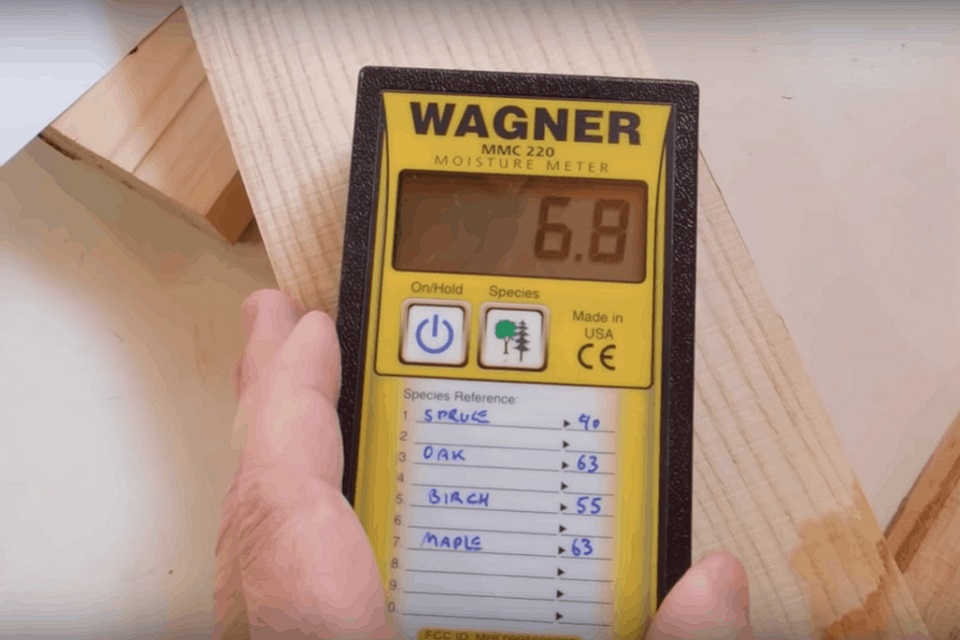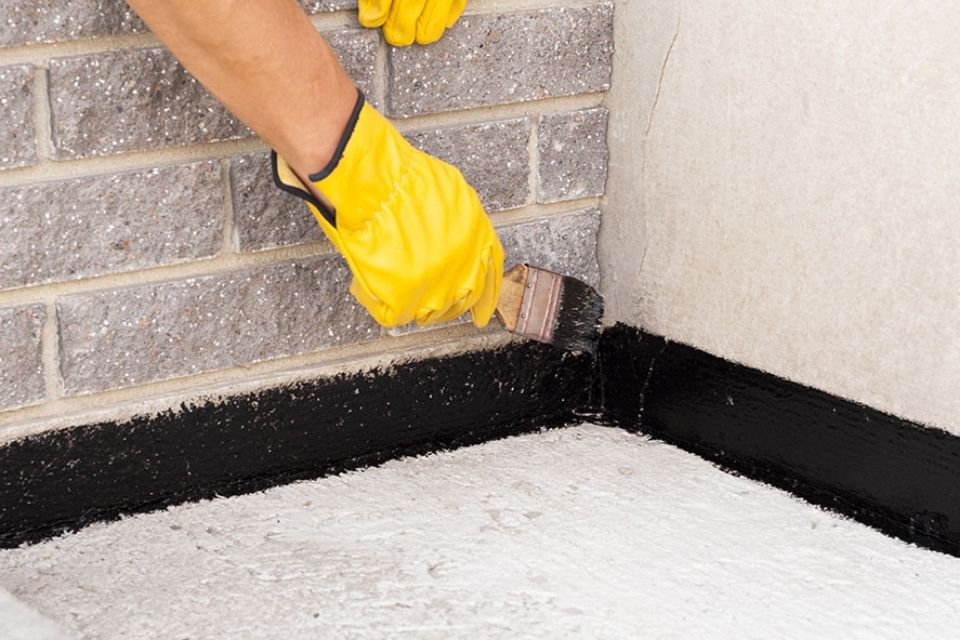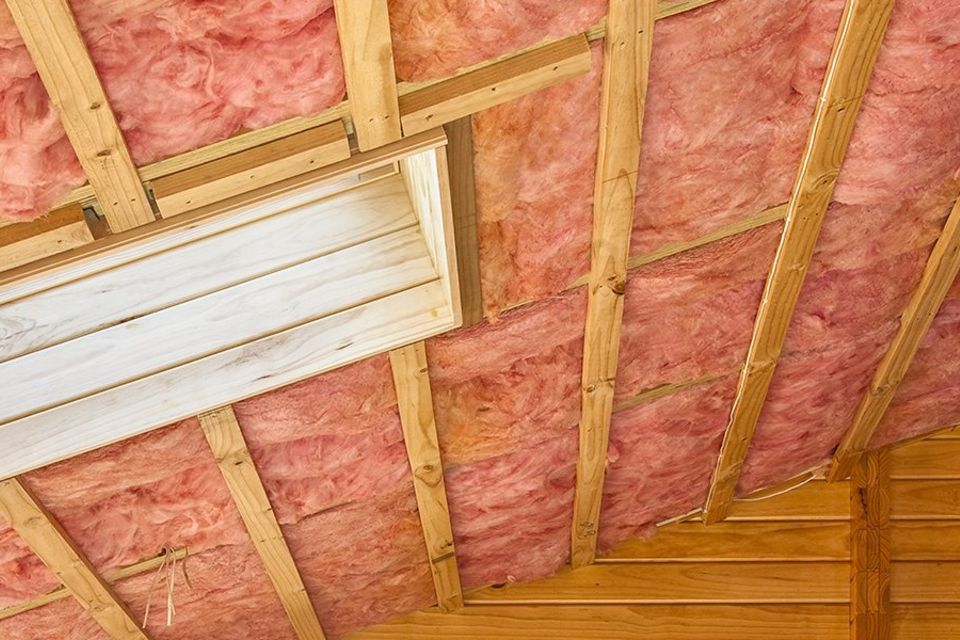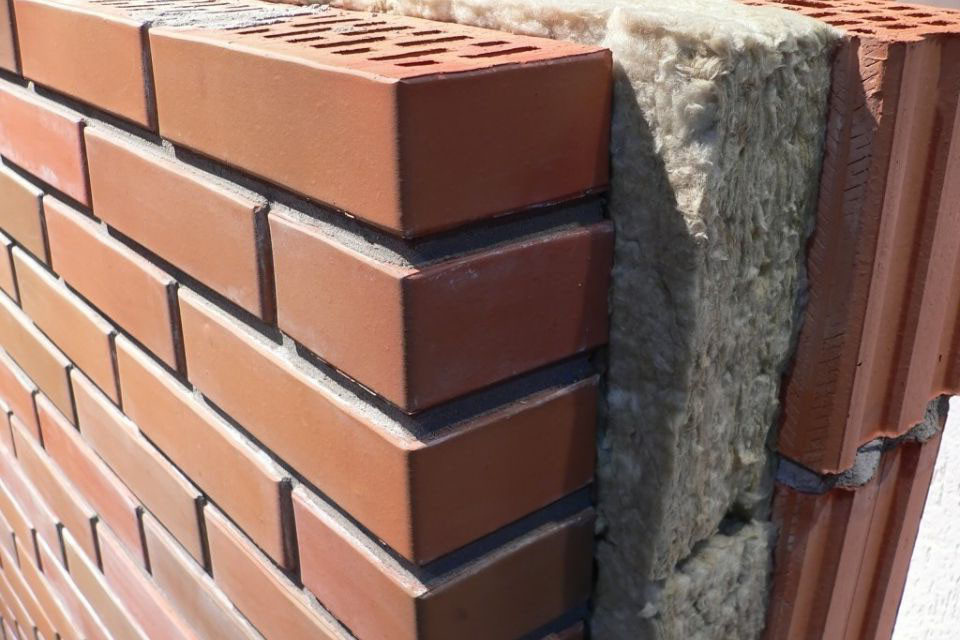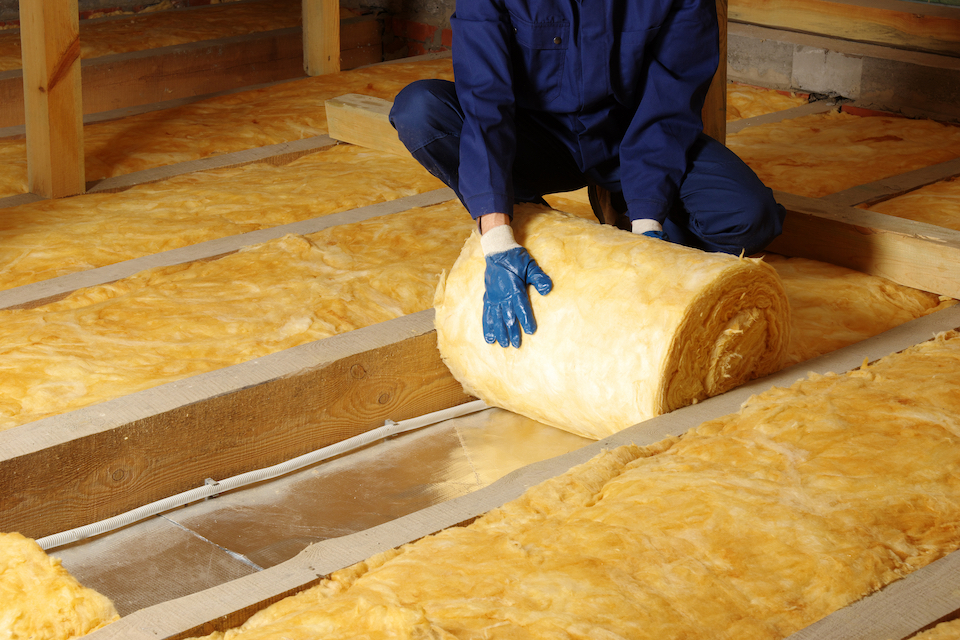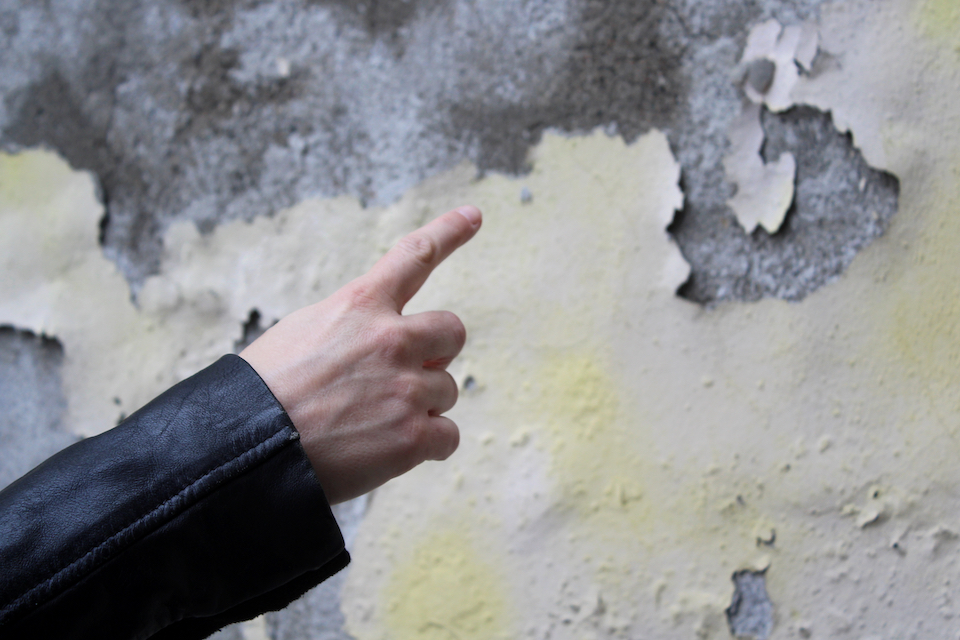Introduction To Moisture Meters
A moisture meter is a great device for determining the moisture levels in a product prior to purchase, to calculate the moisture levels in your home and to identify problems such as signs of a water leakage in your walls or ceiling.
- Introduction To Moisture Meters
- What Is A Moisture Meter?
- How Do You Use A Moisture Meter?
- Pin Moisture Meter
- Pinless Moisture Meter
- All-in-one Moisture Meter
- Best Moisture Meters
- General Tools MMD4E Moisture Meter
- Sam-Pro Tools Dual Moisture Meter
- Extech MO55 Combination Moisture Meter
- Ryboi E49MM01 Pinless Moisture Meter
- Dr. Meter MD918 Wood Moisture Meter
- Calculated Industries 7440 AccuMaster XT Moisture Meter
- Ejoyous 3 in 1 Moisture Meter
- Tramex MEP
- Meterk Handheld Mini Wood Moisture Meter
- LIUMY Digital Moisture Meter
- Best Wood Moisture Meters
- Best Soil Moisture Meters
- Moisture Meter Reading Charts
- Sources
What Is A Moisture Meter?
Moisture meters can allow you to evaluate the levels of moisture in a given spot and may allow you to spot signs of a leak. For this section, we will explain what a moisture meter is, what it does, what it’s used for and who would use a moisture meter.
A moisture meter is a device used to measure the levels of moisture present in a building. They are often used to measure moisture levels in walls. Moisture meters can either work as conductivity meters or as capacitance meters.
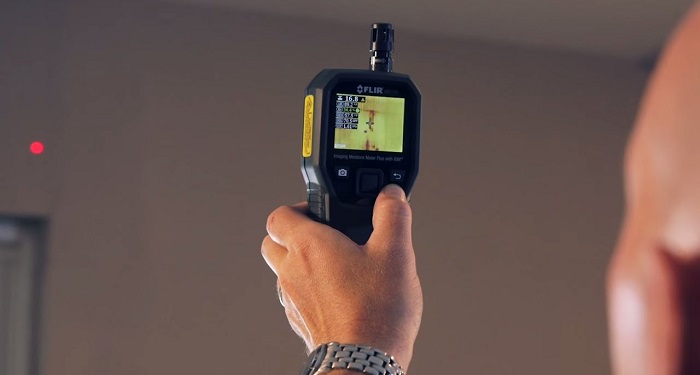
A conductivity moisture meter looks at the electrical resistance to its electrical circuit as a way to estimate the amount of moisture. A capacitance moisture meter carries a conductive plate and the meter then measures the fringe capacitance in the sensor to work out how much moisture exists in the wall.
Moisture meters are often used to identify issues and any structural damage that may have resulted from a build-up of moisture. Home and building inspectors will use moisture meter readings from home inspections to identify such problems. Non-professionals may also use moisture meters for DIY purposes.
How Do You Use A Moisture Meter?
In this section, we will explain how to use a moisture meter. We will break down the various steps involved in using one. How you should use a moisture meter will vary depending on what type of surface you’re trying to measure the moisture from and what type of moisture meter you are using.
Our step by step approach to using a moisture meter is broken down based on type but these exact steps may need to vary depending on the device in question and which material is being tested. We will discuss these types of moisture meters in more detail in the next section.
Using a Pin Moisture Meter
- Power on the moisture meter and set it to the correct mode, based on the material you are testing. Some moisture meters may not require this step, in which case you should follow the instructions of the specific moisture meter you’ve purchased.
- Align the pins perpendicular to the surface before pushing them directly in as far as they can go. Hold the pins in this position.
- Your screen will then give you either a percentage or a reference reading. Take note of the reading.
- Repeat this process several times on other areas of the surface. This will maximise the accuracy of your measurements by taking multiple readings and allowing you to find the average. This is best done on wood surfaces.
Using a Pinless Moisture Meter
- Again, you may need to select a specific setting or mode for the type of material you are testing. If not, check the instructions for your particular device to check whether there are any additional steps required.
- Press the meter up against the wall and apply a small amount of pressure. Hold it for several seconds and wait for the value to stabilise on the meter’s reading screen.
- Take note of the measurement.
- Repeat this process several times by measuring different areas of the same surface. Find the average reading from all of the measurements undertaken.
Pin Moisture Meter
A pin moisture meter utilises pins at the top of the device so that an individual can press the pins against a surface in order to measure the level of moisture present. This device measures the resistance experienced by the electrical current which runs between the pins at the top of the meter.
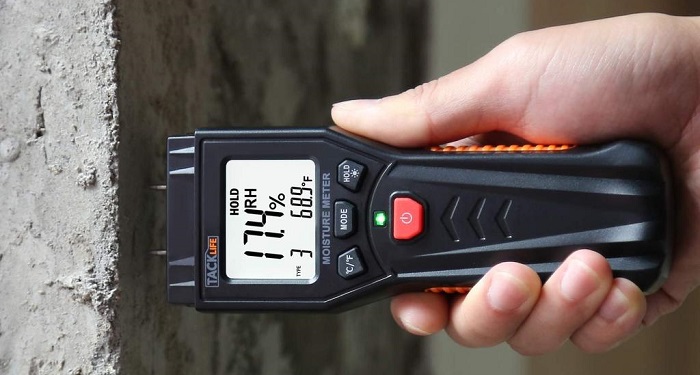
A pin moisture meter uses pins instead of a pad (that a pinless meter uses). Other differences between these two types include that a pin meter can leave holes in the surface it is measuring, pin meters also require different setting adjustments than a pinless device and pin moisture meters also work slower than pinless meters.
Pin moisture meters can be used for scenarios such as testing moisture levels present in uneven areas as well as loose-packed materials and for working out the moisture distribution throughout a board.
Pros
- Provide more accuracy in terms of measuring the depth of moisture present in wood.
- Better able to test moisture levels present in uneven surfaces.
- Better able to test moisture levels in loose-packed materials.
- Strong ability to determine moisture distribution throughout a board.
Cons
- Slower than a pinless moisture meter.
- Can leave holes in the material you are testing.
- Not preferable for testing flat surfaces which are large.
Pinless Moisture Meter
As the name suggests, this device lacks pins. Instead it scans a material for moisture levels using electromagnetic radio frequencies through a pad.
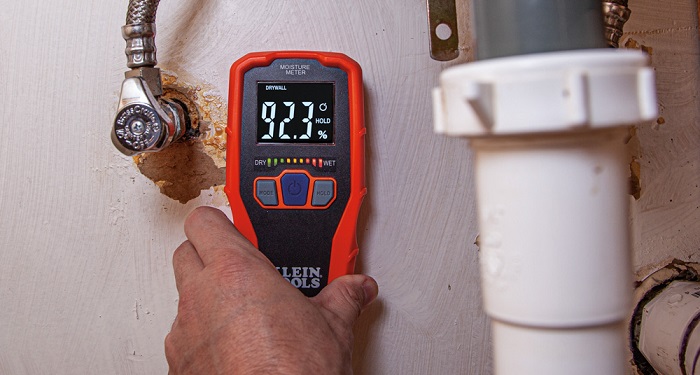
Aspects which distinguish a pinless moisture meter from one with pins include that a pinless device will not leave holes after testing a surface, a pinless moisture meter works faster than a pin-type and a pinless device requires setting adjustments specific to the wood’s density while a pin device does not.
Scenarios in which a pinless moisture meter is best used include for testing surfaces which are large and flat including a room’s entire floor.
This type of moisture meter can be used to test surfaces which you want to avoid damaging since you won’t create holes in the material with this device as you would with a pinned meter.
Pros
- Faster than a pin moisture meter.
- Suitable for testing surfaces which are large and flat.
- Does not leave holes in the material tested.
Cons
- Does not provide the same level of accuracy in terms of estimating the depth of moisture present in wood in comparison to a pin moisture meter.
All-in-one Moisture Meter
We will now look at an all-in-one device. This moisture meter type is designed to combine the benefits of the two aforementioned devices and sometimes a thermo-hygrometer too.
Differences between an all-in-one moisture meter, pin meter and a pinless meter include that an all-in-one meter can switch between a pin and pinless option and an all-in-one device can increase both speed and accuracy in determining the location of moisture pockets.
An all-in-one device might be used as a simpler alternative to switching between a pin and pinless device and is ideal for any of the surfaces which either a pin or pinless device are.
Pros
- Offers the benefits of pin meters and pinless meters.
- Can save space as an all-in-one device rather than having two separate devices.
- Provides an increase in utility.
Cons
- Could be more expensive.
Best Moisture Meters
For this section, we will discuss the best moisture meter products on the market. We will look at the advantages of each of the products discussed, what design features they have, what tech features they have, their displays, their measure range, power source as well as list their pros and cons.
General Tools MMD4E Moisture Meter
This pin-type moisture meter is one of the most popular out there. It comes in an ergonomic size. This meter is a high-quality moisture meter for wood, and it is good for testing moisture in any uneven surfaces. In terms of design features, it’s a pin-type meter that weighs 227g and its dimensions are 14.1 x 24.1 x 3.6 cm.
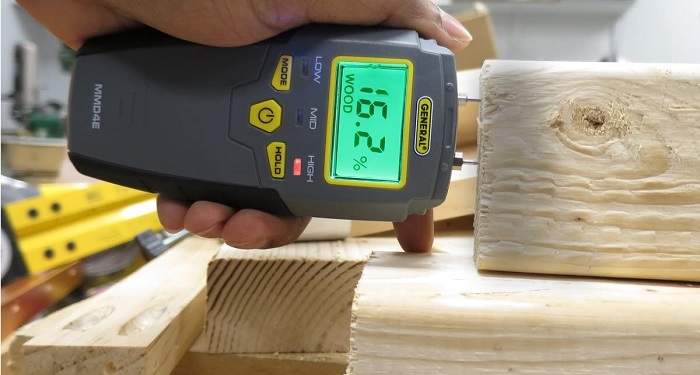
It has a wide and accurate measuring range. This product also has an LCD screen that is easy to read, offering quick and simple viewing. It offers a measuring range of 5-50% for wood. It has a corded-electric power source and is powered by a single 9-volt battery which is included with purchase.
Pros
- Offers an LCD screen with fast and easy viewing.
- Comes with a wide and accurate measuring range.
- Ergonomic.
Cons
- Lacks the benefits of a pinless moisture meter.
- Some users have experienced issues with this meter.
Sam-Pro Tools Dual Moisture Meter
This moisture meter is another pin-based meter which comes with a protective cap. It works relatively fast, especially for a pin-based device and offers a range of unique benefits. It’s good for testing surfaces in dark and difficult to access areas. Its design features include the use of a protective cap and the featuring of pins.
This device includes a backlight to light up the LCD screen so that you can test materials in the dark and in difficult to reach areas. It also comes with an air temperature sensor. It has a sizeable LCD screen. It offers a measuring range of 1 to 70% for wood surfaces. It is powered by a single 9-volt battery which is included.
Pros
- Comes with an air temperature sensor.
- Offers a wide measuring range.
- Features a backlit LCD screen.
Cons
- Lacks the benefits of a pinless moisture meter.
- Features a power down feature which may or may not be preferable.
Extech MO55 Combination Moisture Meter
This meter from Extech is the first all-in-one product to feature in this section. This product is lightweight and comes with the benefits of both a pin and pinless moisture meter.
This product is good for all types of moisture measurement and many use it in order to analyse the after-effects of water leaks behind walls and in the ceiling.
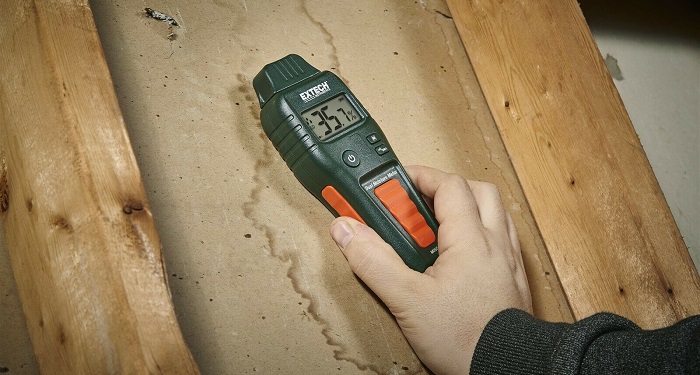
This device is simple to operate and features various display icons that show the levels of moisture present inside the tested surface. Its tech features include an audible alert and a data freeze application. It comes with a small display.
With the use of its pins, it offers a measuring range of 5-50% for wood surfaces and 1.5-33% for building materials. With the pinless sensor, the range for both types of surfaces increases to 0-99.9%. It is powered by a single battery that comes with the product.
Pros
- Offers a fast moisture measurement.
- Comes with an audible alert feature.
- Beneficial for measuring moisture following a water leak behind walls or in the ceiling.
- Provides the benefits of both a pin and pinless meter.
- Has a wide measuring range.
Cons
- More expensive than many other pin-types or pinless products.
Ryboi E49MM01 Pinless Moisture Meter
This meter is the first pinless product in this section. This product has a range of unique features and comes with the various benefits that a pinless meter offers including speed. This product is good for going over delicate surfaces. It's small and ergonomic.
This moisture meter has audible alerts which change their frequency as you go across higher concentrations of moisture. It also comes with varying modes. Unlike most moisture meters, this device has an LED screen.
This product offers a measuring range of 5% to 30% whether for a drywall or wooden surface. It’s powered a 9-volt battery that comes with the product.
Pros
- Works faster than your average pin-type moisture meter.
- Small and ergonomic.
- Features audible alerts.
Cons
- Does not provide as wide a range of measurements as compared to some of the other products on this list.
Dr. Meter MD918 Wood Moisture Meter
This product is another pinless moisture meter. It has a great measuring range and an intelligent shut-off feature. Other benefits include its high levels of accuracy. This product is ideal for measuring delicate surfaces since it is pinless. It is small and relatively lightweight.
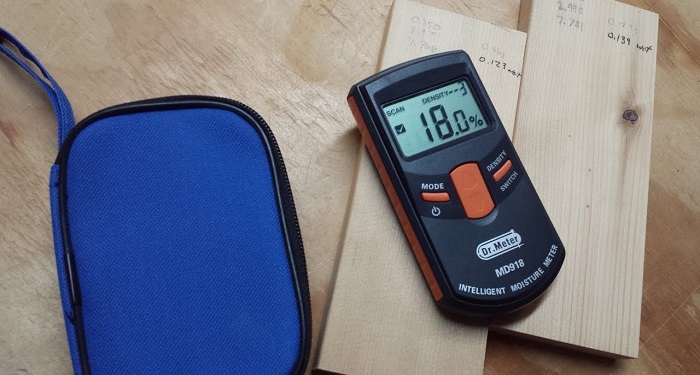
Its intelligent shut-off feature causes the device to turn off following five minutes without any activity. Other tech features include its 10 varying timber density grades and its calibration indication. This product comes with a large HD LCD screen.
It has a measuring range of 4% to 80%. This device is powered by three 1.5-volt AAA batteries which come with this product.
Pros
- Large screen.
- Wide measuring range.
- level of accuracy.
Cons
- Designed for wood use and thus not ideal for measuring moisture inside other materials.
- Lacks some of the additional features which other products come with such as a backlight to the LCD display.
Calculated Industries 7440 AccuMaster XT Moisture Meter
This is a pin-type product. It comes with a backlit display. It’s also easy on the eyes, user-friendly and appropriate for both DIY work and the work of professionals.
It’s good for rapidly identifying damage caused by water and for inspecting the moisture levels present in a material before you purchase it. It’s designed with a protective cover. It comes with hardy and easy to hold rubber grips on its sides.
This product features audible alerts and a hold function which can allow you to freeze the reading appearing on the display screen. This way you can pick up the device and take a closer look at the reading from an easier angle, especially if you are using it to test moisture levels in an awkward spot.
This product has a sizeable LCD screen that comes with a backlight to use in poorly lit or dark areas. Its measuring range is 5% to 50% for wood material. It’s powered by a 9-volt battery which comes with the product.
Pros
- Quickly finds evidence of water damage.
- Backlit LCD display.
- A good measuring range.
- Comes with a protective cover.
Cons
- Comes with a protective cover
Ejoyous 3 in 1 Moisture Meter
This device is a 3 in 1 device, combining the benefits of a pin meter and pinless meter. This product provides a wide measurement range and comes with a backlit display. This product is appropriate for all types of moisture measurement scenarios.
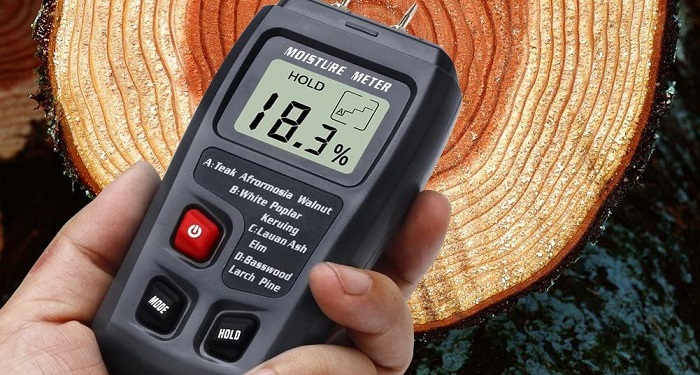
This meter may be used to detect ambient temperatures. It’s small, ergonomic and easy to utilise. It has accurate measurements for two different wood groups and five groups of building materials. This device has an auto shut down feature which works following five minutes of inactivity.
It comes with a backlit HD digital LCD screen. It has a wide measuring range of up to 0% to 54.8% although this will vary depending on which material you’re testing. It is powered by three AAA batteries which come with the purchase.
Pros
- Small and ergonomic.
- Backlit display.
- Wide measuring range.
Cons
- Limited to certain types of materials.
- Requires three batteries as opposed to one.
Tramex MEP
The next product we will look at for this section is the Tramex MEP. It is a pinless meter that offers an alternative for users in that it features an analogue display. It is good for testing materials where you suspect that the water is deep inside.
It is designed as an analogue device all round and comes with small lights to show which material scale you have selected. This device comes with a hold function and it has three sensitivity ranges which are wood & timber, drywall & roofing and plaster & brick.
It has an analogue display with a needle used to point to a specific area of the fixed measurement background. It comes with a measuring range of up to 5% to 30% although it will depend on the material you are testing. This device is powered by a single 9-volt battery which is included with the product.
Pros
- Has three distinct sensitivity ranges.
- Offers a decent measuring range for wood in particular.
- Features a deep penetration signal.
- Includes a hold function.
Cons
- Lacks the benefits of a digital display.
- More expensive than most products on the market.
Meterk Handheld Mini Wood Moisture Meter
This product is a low-cost pin-type meter with a wide and accurate measuring range. It is good for making fast moisture measurements of wood materials. It is small and particularly lightweight.
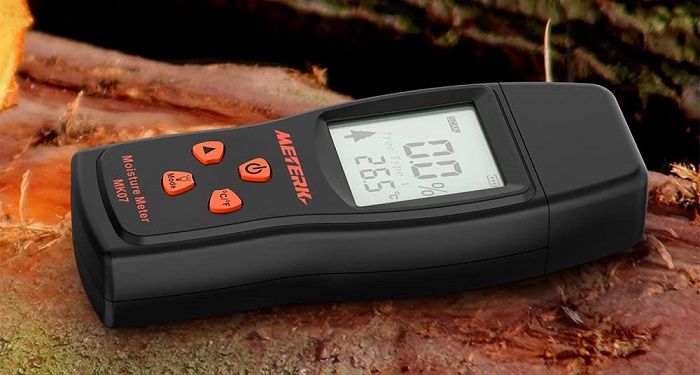
It comes with an auto shutdown feature which kicks in after 10 minutes without any activity and four different operation modes that can be used for a range of wood types. It also has a switchable backlight and a hold function.
It has a large LCD display that’s easy to read. Its measuring range for wood is 2% to 70%. It is powered by three AAA batteries which come with the device.
Pros
- Low-cost.
- Wide measuring range that is accurate.
- 4 operation modes for different wood types.
Cons
- Pins can cause damage to the wood.
- Lacks visual LED alerts.
LIUMY Digital Moisture Meter
This device is a pin-type product that has a very high measuring range and can be used to test wood. It may also be used to detect materials including concrete, brick, drywall and cardboard.
This device is particularly good for measuring moisture levels in wood, but it is also a superior concrete moisture meter. It is small, ergonomic and lightweight at just 141g.
This product includes a hold function. It also comes with an auto shut down feature. It has a 1.7-inch LCD display. This meter has a measuring range of 0% to 99.9%. It is powered by a single 9-volt battery which is not included.
Pros
- Lightweight and ergonomic.
- Easy to utilise.
- Works on many different material types.
Cons
- Battery not included.
- May cause damage to materials due its pins.
Best Wood Moisture Meters
For this section, we will look at the best wood moisture meters.
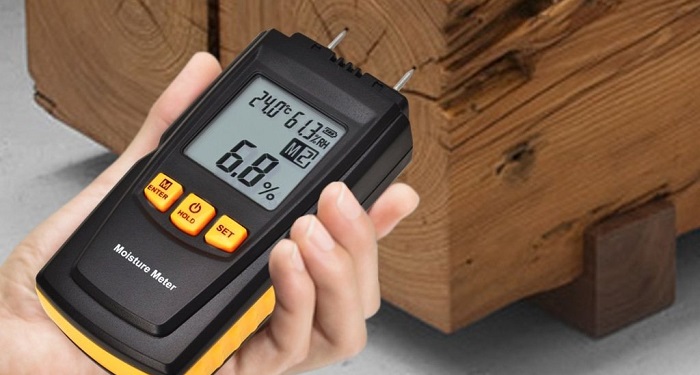
Stanley 077030 Moisture Meter
This Stanley moisture meter is a pin-type product. It has a wide moisture measuring range of up to 6% to 44%. It is popular among many consumers and its LCD screen comes with a dual measurement bar graph. Its maximum measurement is applicable to wood. It is a durable and robust moisture meter.
Check Price on AmazonProtester Damp Meter RZMT-10 MD
This device is one of the best wood moisture meters on the market. It is low-cost and offers a measuring range of up to 0% to 99.9%. It has four modes designed to test on four different types of wood groups, which comprise about 50 wood species in total.
It is a great choice for testing on wood especially given its incredibly low price. You can buy this product for about £11 on Amazon.
Check Price on AmazonBrennenstuhl 1298680 Moisture Detector
This is another popular wood moisture meter. It offers a wide and accurate measuring range of 5% to 50% for wood. It is lightweight and durable. It also only requires a single 9-volt battery although the battery does not come with the product.
This device can be used as a log moisture meter such as for camping. It is reliable and highly accurate. Its audible alerts are another helpful feature.
Check Price on AmazonBest Soil Moisture Meters
We will now take a look at some of the topsoil moisture meters available for purchase.
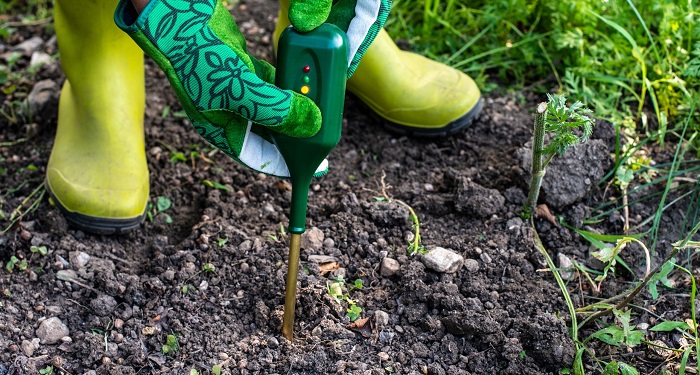
VIVOSUN Soil Tester
This versatile product has a 3-in-1 application as it can test sunlight, moisture and pH levels. The latter feature will allow you to figure out how much sunlight is reaching a given area of your soil.
It is affordable and simple to use. It can work as an effective plant moisture meter. However, it can be a bit slow to respond.
Check Price on AmazonSonkir pH Soil Moisture Meter
Another popular soil moisture meter is provided by Sonkir. It comes with two different reading needles which could possibly increase its overall accuracy when in use. As with the previous product, this meter can test sunlight, moisture and pH levels alike.
This product is also an example of a firewood moisture meter. It should be noted that some consumers have had issues with the accuracy of its readings.
Check Price on AmazonGain Express Ph & Soil Moisture Meter 295mm
Arguably, this product is the best to feature in this section. It has a pH level detection range of 3-8, it's simple to use and it comes with an easy to read interface.
This device does not require batteries and doesn’t need a set-up. One of its potential downsides is that it can be slow to give a reading.
Check Price on AmazonMoisture Meter Reading Charts
In this section, we will discuss what a moisture reading chart is and what the different types of moisture readings mean. A moisture meter reading chart is designed to explain the meaning of the readings your device has picked up. This can allow you to figure out what the moisture meter acceptable levels are.
Your meter may provide you with precise, quantitative results but without a chart to reference, you may not know what the numbers it's showing actually means. Wood and lumber should have moisture levels of 6% to 8% for internal materials while external wood and lumber should have levels of 9% to 14%.
For a drywall, an ideal moisture reading is between 5% and 12%. If it goes above 17% then the drywall may need to be replaced as this is a sign that it has experienced water damage.
Bricks should not have a moisture level above 20% and when it comes to concrete, the moisture levels should not exceed 12% for lightweight concrete or 20% for high density concrete. Moisture measurement charts will show you levels beyond these estimated acceptable moisture level ranges as being of concern.
Many reading charts will also vary slightly. By understanding a moisture meter reading chart, you will be on your way to identifying any issues or the lack thereof regarding moisture levels in your home.
Sources
- https://www.restorationuk.com/about-restorationuk/restorationuk-news/moisture-meters-and-damp-measurement
- https://www.grainger.com/know-how/equipment-information/kh-types-of-moisture-meters-qt-346
- https://www.wonkeedonkeetools.co.uk/moisture-meters/how-to-use-a-pin-type-moisture-meter
- https://www.measurementshop.co.uk/blog/guides/the-measurement-shop-s-guide-to-moisture-meters
- https://www.wagnermeters.com/moisture-meters/wood-info/pin-pinless-meter-differences/
- https://www.delmhorst.com/blog/when-to-use-pin-and-pinless-moisture-meters
- https://www.thearchitectsguide.com/articles/best-moisture-meter

